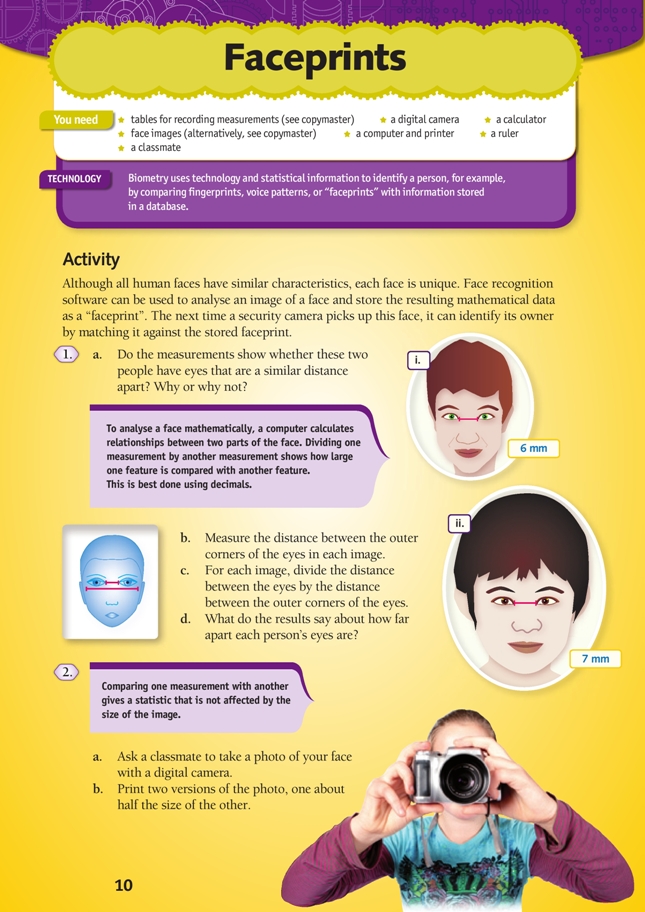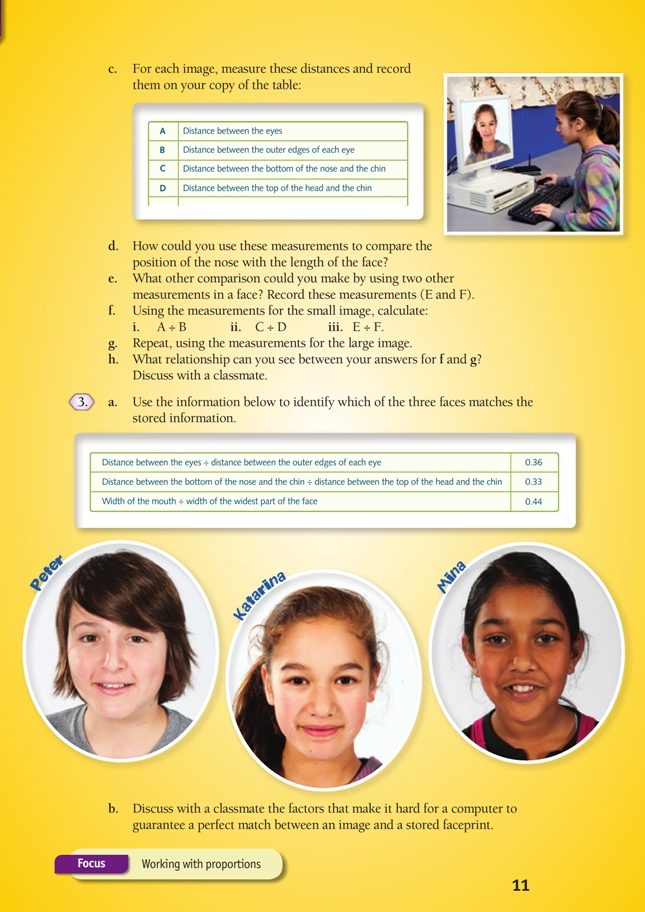This is a level 4-5 activity from the Figure It Out series.
A PDF of the student activity is included.
Click on the image to enlarge it. Click again to close. Download PDF (655 KB)
Proportion involves comparing one aspect of an object or image with another aspect. The emphasis is on the relationship between measurements, not the measurements themselves. Ratios can be used to quantify this comparison and can be expressed in several ways. For example, if a person’s arm span is 146 cm and their height is 150 cm, this can be expressed as an arm span : height ratio of 146:150 or 146/150 or just 0.97 (146 ÷ 150). In this activity, students use ratios expressed as decimals to compare proportions in faces and demonstrate that proportions remain constant when an image is enlarged or reduced.
face images (alternatively, see copymaster)
a calculator
a computer and printer
a ruler
a digital camera
tables for recording measurements (see copymaster)
a classmate
FIO, Technology Transformations, Levels 3+-4+, Faceprints, pages 10 - 11
In this activity, students use measurement to explore proportions.
Discuss proportion with the class. As a fun introduction, show students some out-of-proportion images. These can be easily found by doing an Internet search for “out of proportion animals”.
A single measurement in an image tells us nothing unless we know that the image is life-sized or it comes with a scale. However, if there are two measurements, we can find the size of one measurement compared with another. This makes the size of the image irrelevant because the relationship between the two measurements is constant.
Accuracy of measurement is important in this activity.
Ratios calculated from measurements in the larger image are likely to be more accurate than those derived from the smaller image. This is because precision of measurement is relative to size. (It’s easier to take meaningful measurements from a large picture than from a postage stamp.) So, in question 2, students are unlikely to get exactly the same results for f and g. Discuss the reasons for this with the students. If a student’s measurements are very different, check their measuring technique.
To identify which face matches the stored information, the students need to interpret the required distances. Two students measuring the width of the mouth may get slightly different results because of their different interpretations of where the mouths end. If the students have participated in Census at School (www.censusatschool.org.nz), they will understand the importance of defining the method in sufficient detail for measurements to be consistent. This is a useful discussion point, and connections can be made to both the fallibility of computers in terms of guaranteeing a match with a stored faceprint and the need to carefully define parameters when collecting data.
If time or access to cameras or computers is an issue, use the face copymaster provided instead of images of students.
Exploring situations that involve proportional reasoning develops the key competency thinking.
Technology-related student activities
- Do a plus, minus, interesting analysis of the use of voice- or finger-recognition to start a car.
- Brainstorm ways that face recognition technology could be used at school or in workplaces.
Exploring the technology-related context
Technological advances have made it possible to quickly identify people by comparing information about their unique physiological features with database records. Some security systems use eye, voice, and hand geometry to allow access to restricted areas. A recent development is a prototype car that uses a finger-scanning system to adjust the mirrors and seats and to start the engine.
Answers to activity
1. a. The images are different sizes, so we can’t compare the measurements. The face above has eyes that look further apart than the face below, but the measurement is smaller because the image is smaller.
b. i. 17 mm
ii. 22 mm
c. i. 0.35 mm
ii. 0.32 mm
d. The ratio for the face above is larger than the ratio for the face below. This tells the computer that, relatively speaking, the person above has eyes that are further apart than the person below.
2. a.–c. Practical activity. Answers will vary.
d. Divide C by D.
e. Answers will vary. Possible relationships include: the width of the mouth compared with the width of the face; the width of the face compared with the length of the head.
f.–g. Answers will vary.
h. The results for f and g should be very similar or the same. If there are minor differences, this will be because it is hard to take accurate measurements from a small image.
3. a. Peter’s face
b. Answers will vary. Possible factors include: some faces have similar proportions; the image needs to be face-on; the person could be wearing sunglasses or a hat; the image needs to be high-definition to take accurate measurements; if the image is very small, it will be hard to differentiate between faces because the measurements will be less precise; the width of the mouth when a person is smiling is different from the width when they are pouting.

